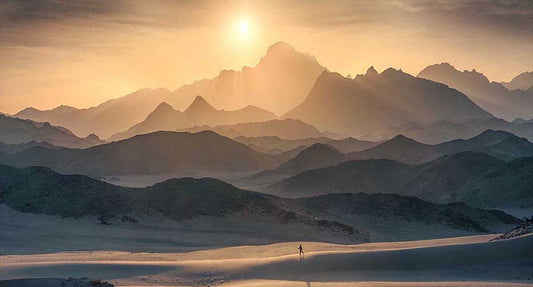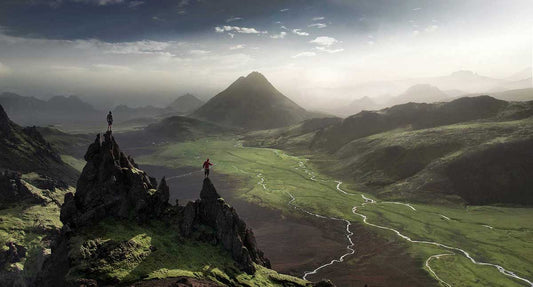Are you just starting out on your landscape photography journey and unsure how to start taking quality photos? Maybe you've taken a few photos that piqued your interest, but now you're feeling overwhelmed because the gap between where you are and where you want to be feels massive! Well, you've come to the right place. In this article, I’ll share the top five things every beginner landscape photographer should focus on. This is the same method I followed myself and after 15 years, I still follow these simple methods.
1. Shoot, Shoot, and Shoot Some More
So many people get caught up in the idea of capturing “the perfect shot.” But it’s not about perfection, and honestly, you probably don’t even know what that perfect shot looks like yet. The key is to take as many shots as possible. Review them as you go, and make adjustments to improve each time. By making those judgments, you learn what makes a good photo and what doesn’t. That’s a great starting point!
When I first started taking photos, it was on a hiking trip from the Netherlands to France. The photos I was capturing were more like travel snapshots—the scenery, the mountains, the lakes. During this trip, I took hundreds of photos and started to learn what subjects caught my eye the most. I found that I was particularly drawn to mountains, their scale, textures, and how they changed under different lighting conditions. It was through this constant practice that I began to understand composition and storytelling in landscape photography.
One way to develop your skills is to set a challenge for yourself. Try taking photos at different times of the day—morning, afternoon, and evening. Experiment with lighting conditions, shoot in different weather, and try various angles. You’ll be amazed at how a single location can look dramatically different depending on the time and conditions.
Additionally, don’t be afraid to make mistakes. Some of the best lessons come from reviewing the shots that didn’t turn out well. Look at your photos critically—what worked and what didn’t? Over time, this analytical approach will refine your skills and improve your eye for composition.
2. Start Simple with Your Gear
A camera is a great starting point, and I recommend beginning with a small, lightweight camera. Don’t get too caught up in the brand—honestly, it’s not important at this stage. What matters most is getting comfortable with your equipment and understanding how to use it effectively.
Beyond that, I recommend investing in two lenses: a wide-angle lens and a telephoto zoom lens. These give you flexibility in what you can photograph, and that’s really all you need to begin. A wide-angle lens is perfect for capturing grand, sweeping landscapes, while a telephoto lens allows you to zoom in on distant details, isolate subjects, and create compression effects that can make landscapes feel even more dramatic.
Keep it simple, and don’t feel the need to spend a fortune. Too many lenses can also result in a heavy backpack, which makes the overall experience of exploring less enjoyable. I remember that during my hiking trip, I had only a compact digital camera with me, and even with such basic equipment, I was able to learn the fundamentals of composition and light. So don’t let the gear you have limit you—just start shooting!
3. Move Around – No Tripods Yet!
When you're just starting out in landscape photography, it's crucial to develop your eye. You need to see the composition from multiple angles and train yourself to identify the best shot. You can’t do this if your camera is locked into a tripod while you stand in one spot, pressing the shutter button for 10 minutes. Instead, move around, keep your hand steady, and search for different perspectives.
For instance, instead of standing at eye level, try crouching low to the ground to include foreground elements that add depth to your composition. Or, find a higher vantage point that provides a bird’s-eye view of the landscape. Walking around and exploring different angles will train you to see compositions more effectively.
If you need a stable surface for your camera because you are shooting with low shutter speeds, balance it on your knee or a rock. This will work just as well as a tripod while giving you more freedom and less weight to carry when adventuring. Later, once you’ve developed a good eye for composition, you can introduce a tripod for more controlled and refined shots.
4. Find Inspiration, But Be Original
It’s great to be inspired by others; in fact, it’s probably how you got into photography in the first place! Find photographers who inspire you and study their work. Ask yourself why you like their photos—what makes them stand out? Is it their composition, lighting, or post-processing style? Understanding what you admire will help you develop your own photographic eye.
However, it’s important not to fall into the trap of copying other photographers’ work. While it’s good practice to analyze and learn from others, it’s a disservice to yourself if you simply replicate their shots. Use your own creativity to find fresh compositions and unique perspectives.
If you love a particular location, go there, study the landscape, and then challenge yourself to find your own take on it. Ask yourself: What makes this place special to me? How can I capture it in a way that tells my own story? By doing this, you’ll start to develop your own signature style.
5. Edit Like a Pro – Find Your Style
When you’re a beginner, developing your own editing style can feel overwhelming. Start by experimenting with editing tools like Adobe Lightroom or Capture One. Familiarize yourself with the basics—adjusting exposure, contrast, highlights, and shadows. These simple adjustments can dramatically improve your photos.
As you become more comfortable, start refining your style. Do you like vibrant, bold colors, or do you prefer a softer, more calm palette? Do you enjoy high contrast and deep shadows, or do you lean toward bright, airy landscapes? Your editing style will evolve over time, so don’t be afraid to experiment.
Watch a few tutorials to understand different editing techniques, and practice with your own photos. Over time, you’ll develop an editing approach that feels uniquely yours. Remember, editing is an extension of your creativity—it’s the final step in bringing your vision to life.
6. Online Discussion Forum
When you start being active online try websites which encourage constructive criticism. We all want that our work is getting recognized and receive praise. We don't come back with photos from a trip and say, these photos are not very good. Especially with something like art there is no right or wrong - in our own eyes. Therefore it is essential to receive feedback from people more experienced. I started sharing my work on a Dutch forum. There was only one rule - comment on the photo previously posted by another user - and receive feedback from the person who will post after you. Did I always like the feedback or agreed with it? Absolutely not. But, it helped me a lot to keep all the critique in my mind and the next time when shooting, I would consider if it made sense to apply that feedback. Sometimes it didn't, but other times it did. That was when I realized the value in the comments people made. It will help you to create a more critical view on your own work based on feedback.
While I was active on a Dutch forum because I am from The Netherlands, there are also plenty of international forums too. A good website is DPReview. They also have weekly contests you can participate in.
Another website which can be useful for a beginner is 1x.com. They have a curating system so your work will first be judged by other users who can also leave feedback. After the other users judge your photo it will go to the curators. If it then gets approved by the curators your photo will be published on the website. Keep in mind this website is meant for experienced photographers. You might be disappointed or even frustrated when many of your photos don't get selected. But, when you start it is all about the journey, developing your style and getting better. The many rejected photos on 1x.com will only help you to think more critically of your own work.
7. Use Google Earth
Yes, use a tool many advanced photographers might not even use today. This tool was one of the reasons that really early on in my photography career I could find unique viewpoints no one else went to. Implementing Google Earth from the start will allow you to find more places. When you are not using it from the start, you might end up on repeat going to spots already discovered. This will probably give you the most impressive (but not very original) photos. As a result you can't be bothered by using Google Earth to find something probably not even half as good. But, just like photography and any other hobby, it requires time. The more time you use Google Earth, the better you become at using it to find great spots. Being better with Google Earth also means becoming a better photographer.
Final Thoughts
Landscape photography is an exciting journey, and as a beginner, it’s all about getting comfortable with your camera, experimenting, and finding your unique style. Focus on taking as many photos as possible, keep your gear simple, explore different perspectives, and never stop learning from others. With time, patience, and practice, you’ll start to see improvement, and before you know it, you’ll be capturing stunning landscapes that reflect your vision.
Remember, photography is as much about the process as it is about the end result. Keep shooting, stay inspired, and most importantly—have fun!
Max Rive is most driven by seeking new perspectives in the natural world and capturing them in his own distinguished style. Max's powerful portrayals of his interactions with the mountains has earned him international recognition in the outdoor community.
Madison McCardle is a passionate landscape photographer driven by curiosity and a desire to capture the true essence of each place she explores. Through her lens, she seeks new perspectives that reveal the beauty and authenticity of the world.
✉️ JOIN US TODAY
Don't miss out on wallpapers, E-books and tour announcements!
DISCUSSION
LEAVE A COMMENT
Your Email Address Will Not Be Published. Required Fields Are Marked *



























No comments